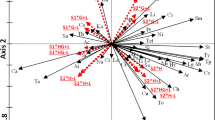Abstract
Beneficial invertebrate numbers in two organic leek fields in eastern England were assessed in relation to four field margin vegetation treatments (clover/grass, regeneration, two flower mixtures) using pitfall and pan traps. Damage caused by onion thrips in one field was also estimated. Clover/grass and regeneration margins generally had more beneficial invertebrates than either flower mixture margins and invertebrate numbers in the fields were least opposite flower mixture margins. Distance from field margins had a greater effect on invertebrate numbers, with most ladybirds (Coccinellidae), hoverflies (Syrphidae), lacewings (Neuroptera) and parasitic wasps (Hymenoptera) recorded from the middle of fields. High ladybird, hoverfly and parasitic wasp (Icheumonidae) numbers were associated with lowest onion thrip damage, but there was no evidence that field margin treatments were related to damage. Sown flower mixture margins did not positively affect beneficial invertebrate numbers in the leek crop. It appears that an approach in keeping with elements already in the landscape would be just as effective as the use of alien vegetation mixtures in generating invertebrate natural enemy activity in vegetable fields of eastern England.




Similar content being viewed by others
References
Armstrong G, McKinlay RG (1997) The effect of undersowing cabbages with clover on the activity of carabid beetles. Biol Agric Hortic 15:269–277
Berry NA, Wratten SD, McErlich A, Frampton C (1996) Abundance and diversity of beneficial arthropods in conventional and “organic” carrot crops in New Zealand. N Z J Crop Hort Sci 24:307–313
Crawley MJ (2007) The R Book. Wiley, Chichester
Deligeorgidis PN (2002) Predatory effect of Orius niger (Wolff) (Hem., Anthocoridae) on Frankliniella occidentalis (Pergande) and Thrips tabaci Lindeman. J Appl Entomol 126:82–85
Deligeorgidis PN, Ipsilandis CG, Vaiopoulou M, Kaltsoudas G, Sidiropoulos G (2005) Predatory effect of Coccinella septempunctata on Thrips tabaci and Trialeurodes vaporariorum. J Appl Entomol 129:246–249
Eyre MD, Foster GN, Luff ML, Rushton SP (2006) The definition of British water beetle species pools (Coleoptera) and their relationship to altitude, temperature, precipitation and land cover variables. Hydrobiologia 560:121–131
Hoddle MS, Robinson L (2004) Evaluation of factors influencing augmentative releases of Chrysoperla carnea for control of Scirtothrips perseae in California avocado orchards. Biol Control 31:268–275
Landis DA, Wratten SD, Gurr GM (2000) Habitat management to conserve natural enemies of arthropod pests in agriculture. Ann Rev Entomol 45:175–201
Landis DA, Menalled FD, Costamagna AC, Wilkinson TK (2005) Manipulating plant resources to enhance beneficial arthropods in agricultural landscapes. Weed Sci 53:902–908
Leifert C, Rembialkowska E, Nielson JH, Cooper JM, Butler G, Lueck L (2007) Effects of organic and ‘low input’ production methods on food quality and safety. In: Niggli U, Leifert C, Alföldi T, Lück, L, Willer H (eds) Improving sustainability in organic and low input food production systems. Research Institute of Organic Farming, Frick, Switzerland. pp. 75–95
Luff ML (2007) The Carabidae (ground beetles) of Britain and Ireland, 2nd edn. Handb Identif Br Insects 4(2):1–247
Lys JA, Zimmermann M, Nentwig W (1994) Increase in activity density and species number of carabid beetles in cereals as a result of strip management. Entomol Exp Appl 73:1–9
MacLeod A, Wratten SD, Sotherton NW, Thomas MB (2004) ‘Beetle banks’ as refuges for beneficial arthropods in farmland: long-term changes in predator communities and habitat. Agric For Entomol 6:147–154
Marshall EJR, Moonen AC (2002) Field margins in northern Europe: their functions and interactions with agriculture. Agric Ecosyst Environ 89:5–21
Meek B, Loxton D, Sparks T, Pywell R, Pickett H, Nowakowski M (2002) The effect of arable field margin composition on invertebrate biodiversity. Biol Conserv 106:259–271
O’Sullivan CM, Gormally MJ (2002) A comparison of ground beetle (Carabidae: Coleoptera) communities in an organic and conventional potato crop. Biol Agric Hortic 20:99–110
Pinheiro JC, Bates DM (2000) Mixed-effects models in S and S-PLUS. Springer, New York
Prasad RP, Snyder WE (2004) Predator interference limits fly egg biological control by a guild of ground-active beetles. Biol Control 31:428–437
Prasad RP, Snyder WE (2006) Polyphagy complicates conservation biological control that targets generalist predators. J Appl Ecol 43:343–352
R Development Core Team (2008) R: A language and environment for statistical computing. R Foundation for Statistical Computing, Vienna
Riudavets J, Castane C (1998) Identification and evaluation of native predators of Frankliniella occidentalis (Thysanoptera: Thripidae) in the Mediterranean. Environ Entomol 27:86–93
Schade M, Sengonca C (1998) On the development, feeding activity and prey preference of Hippodamia convergens Guer.-Men. (Col., Coccinellidae) preying on Thrips tabaci Lind. (Thrys., Thripidae) and two species of Aphidae. Anz SchaÉdlkd Pflanzenschutz Umweltschutz 71:77–80
Ter Braak CJF, Šmilauer P (1998) CANOCO reference manual and user’s guide to CANOCO for windows: software for canonical community ordination (version 4). Centre for Biometry, Wageningen
Theunissen J, Legutowska H (1991) Thrips tabaci Lindeman (Thrasanoptera, Thripidae) in leek—within plant distribution. J Appl Entomol 112:309–316
Theunissen J, Schelling G (1997) Damage threshold for Thrips tabaci (Thysanoptera: Thripidae) in monocropped and intercropped leek. Europ J Entomol 94:253–261
Theunissen J, Schelling G (1998) Infestation of leek by Thrips tabaci as related to spatial and temporal patterns of undersowing. Biocontrol 43:107–119
Acknowledgements
This work was supported by the European Union Integrated Project QualityLowInputFood (EU FP6 Contract CT-2003-506358.). We thank two reviewers for ideas on improving the paper.
Author information
Authors and Affiliations
Corresponding author
Rights and permissions
About this article
Cite this article
Eyre, M.D., Labanowska-Bury, D., White, R. et al. Relationships between beneficial invertebrates, field margin vegetation, and thrip damage in organic leek fields in eastern England. Org. Agr. 1, 45–54 (2011). https://doi.org/10.1007/s13165-010-0004-x
Published:
Issue Date:
DOI: https://doi.org/10.1007/s13165-010-0004-x




